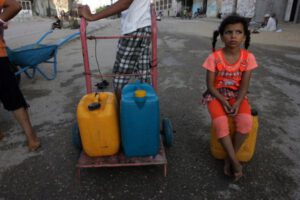 Gaza will no more be “habitable” by 2020 unless urgent action is taken to ameliorate water system, power, health, and schooling, the UN’ broadest report on the Palestinian enclave told on Monday.
Gaza will no more be “habitable” by 2020 unless urgent action is taken to ameliorate water system, power, health, and schooling, the UN’ broadest report on the Palestinian enclave told on Monday.
“Action requires to be taken now if Gaza is to be a habitable place in 2020 and it’s already hard now,” United Nations humanitarian coordinator Maxwell Gaylard said to journalists when the report was brought out on Monday.
5 years into an Israeli barricade supported by Egypt, and living under one-party rule, Gaza’s population of 1.6 million is set to rise by 500,000 over the next 8 years, tell the authors of the United Nations biggest report on the territory.
Gaza has one the youngest populations in the world, with fifty-one percent of people under the age of 18.
“Action needs to be taken right now on fundamental aspects of life: water sanitation, electricity, education, health and other aspects,” Gaylard said.
Since 2007, Gaza has been under the control of the Islamist Hamas organisation, an armed political movement which disapproves permanent peace with Israel. They fought a three-week war in January 2009, and Israel is resisting international pressure to lift its blockade, which it says prevents arms reaching Hamas.
Gaza has no airport and no harbor. The border is tense, with frequent clashes over rocket or mortar fire from Gaza and air strikes by Israel. Gaza rockets hit Israeli land on Sunday, damaging a factory in the town of Sderot, east of the enclave.
Israel partly eased limitations in mid-2010, and Gaza’s crippled economy started to revive from rock bottom. Real gross domestic product is estimated to have risen by twenty-eight percent in the first half of 2011 as unemployment fell to 28 percent in 2011 from 37 percent.
But the report, involving expertise from more United Nations agencies and making projections further into the future than before, said growth over the next 8 years would be slow, since Gaza’s actual isolation renders its economy essentially non-viable.
The people in the narrow coastwise strip live primarily on United Nations aid, foreign funding and a tunnel economy which brings in food, building materials, electronics and cars from Egypt.
But the smuggling trade is no solution. Robert Turner, director of operations of the United Nations Relief and Works Agency (UNRWA), told Gaza by 2020 will call for 440 more schools, 800 more hospital beds and over a 1,000 additional doctors.
Gaylard called on international donors to increase their aid to a population which is 80 percent aid dependent.
“In spite of their best efforts the Palestinians in Gaza still need help,” he said. “They are under blockade. They’re under occupation and they need our help both politically and practically on the ground.”
Israel in fact backed away from Gaza in 2005, removing troops and settlers after thirty-eight years of occupation.
A lack of clean drinking water is the biggest immediate concern, told Jean Gough of the UNICEF. The report projects a 60 percent increase in the enclave’s water needs, while urgent action is already needed to protect existing water resources.
By 2016, Gaza’s aquifer might become unusable, she told. Palestinians are already drilling deeper and deeper to arrive at groundwater and there has been a need for more desalination plants. A seawater plant costing about $350 million is planned.
The United Nations tells only a quarter of Gaza waste water is treated. The rest, including raw sewage, goes into the Mediterranean Sea.
Gaylard told Gaza needs peace and security to ameliorate the lives of its people. “It will certainly have to mean the cease of blockade, the end of isolation and the end of conflict.”
There is as yet no sign of an cease to the conflict between Hamas and Israel. The Islamist movement is banished by the West as a terror organisation and there has been no aspect of diplomatic contacts leading to peace talks as long as Hamas disapproves Israel’s right to exist.
Analysts say much may depend on the future of relations with the new Egypt, whose Islamist leaders are sympathetic to Hamas but also committed to the 1979 peace treaty with Israel. Hamas is also supported by Iran, which is extremely hostile to Israel.
Aside from its tunnel network, Gaza imports via Israel. UN figures show, for example, that 46,500 tonnes of building materials came into Gaza via the Kerem Shalom crossing from Israel in September 2011, while 90,000 tonnes came via the tunnels.
It also gets electricity and fuel from Israel.
Rebuilding homes and factories smashed in the winter war of 2009 is Gaza’s biggest task, and construction is the source of most of its growth in employment in the past two years















